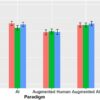Researchers have demonstrated that stretching shape-memory polymers embedded with clusters of gold nanoparticles alters their plasmon-coupling, giving rise to desirable optical properties. One potential application for the material is a sensor that relies on optical properties to track an object or environment’s thermal history.
At issue is a stretchable polymer embedded with gold nanospheres. If the material is heated and stretched, followed by cooling to room temperature, the material will hold its stretched shape indefinitely. Once reheated to 120 degrees Celsius, the material returns to its original shape.
But what’s really interesting is that the gold nanospheres are not perfectly dispersed in the polymer. Instead, they form clusters, in which their surface plasmon resonances are coupled. These plasmon-coupled nanoparticles have optical properties that shift depending on how close they are to each other, which changes when stretching alters the shape of the composite.
“When assessing the peak wavelength of light absorbed by the material, there are significant differences depending on whether the light is polarized parallel or perpendicular to the stretching direction,” says Joe Tracy, corresponding author of a paper on the work and a professor of materials science and engineering at NC State. “For light polarized parallel to the direction of stretching, the further you have stretched the material, the further the light absorbed shifts to the red. For light polarized perpendicular to the stretching direction there is a blueshift.”
“We also found that, while the shape-memory polymer holds its shape at room temperature, it recovers its original shape in a predictable way, depending on the temperature it is exposed to,” says Tobias Kraus, co-author of the paper, a group leader at the Leibniz Institute for New Materials and a professor at Saarland University.
Specifically, once stretched 140% past its original length, you can determine the highest temperature to which the polymer is then exposed, up to 120 degrees Celsius, by measuring how much it has shrunk back toward its original size. What’s more, because of the plasmon-coupled nanoparticles, this change can be measured indirectly, through measurements of the material’s optical properties.
“From a practical perspective, this allows you to create an optical thermal-history sensor,” Joe Tracy says. “You can use light to see how hot the material got. An important application of thermal-history sensors is assuring the quality or safety of shipping or storing materials that are sensitive to significant changes in heat. We have demonstrated an approach based on plasmon coupling of gold nanoparticles.”
The sensor concept was developed empirically, but the researchers also used computational modeling to better understand the structure of the clusters of gold nanospheres and how the clusters changed during stretching. The strength of plasmon coupling is related to the spacings between nanospheres, which is known as a “plasmon ruler.”
“Based on our simulations, we can estimate the distance between plasmon-coupled nanoparticles from their optical properties,” says Amy Oldenburg, co-author of the paper and a professor of physics at the University of North Carolina at Chapel Hill. “This comparison is informative for designing future polymer nanocomposites based on plasmon-coupled nanoparticles.”
Using gold nanoparticles to trigger sequential unfolding of 3-D structures
More information:
Prachi R. Yadav et al, Plasmon-Coupled Gold Nanoparticles in Stretched Shape-Memory Polymers for Mechanical/Thermal Sensing, ACS Applied Nano Materials (2021). DOI: 10.1021/acsanm.1c00309
Provided by
North Carolina State University
Citation:
Plasmon-coupled gold nanoparticles useful for thermal history sensing (2021, March 26)
retrieved 28 March 2021
from https://phys.org/news/2021-03-plasmon-coupled-gold-nanoparticles-thermal-history.html
This document is subject to copyright. Apart from any fair dealing for the purpose of private study or research, no
part may be reproduced without the written permission. The content is provided for information purposes only.



